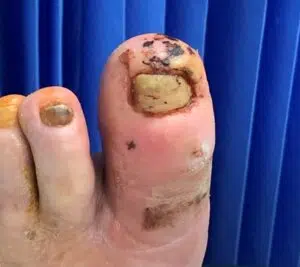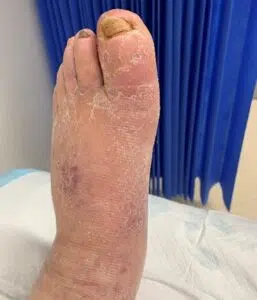Short Communication | Vol. 5, Issue 1 | Journal of Clinical Medical Research | Open Access |
Application of HBOT with Minimally Invasive Guided Surgery to Heal chronic Brooker 4 Diabetic Ulcer
Gordon Slater1*

1Clinical Private Practice, Potts Point NSW Sydney, Australia
2MBiomedEng, University of Technology Sydney, Ultimo NSW Sydney, Australia
*Correspondence author: Gordon Slater, MBBS FRACS FA OrthoA, Clinical Private Practice, Potts Point NSW Sydney, Australia; Email: gordonjakll@gmail.com
Citation: Slater G, et al. Application of HBOT with Minimally Invasive Guided Surgery to Heal chronic Brooker 4 Diabetic Ulcer. Jour Clin Med Res. 2024;5(1):1-5.
Copyright© 2024 by Slater G, et al. All rights reserved. This is an open access article distributed under the terms of the Creative Commons Attribution License, which permits unrestricted use, distribution, and reproduction in any medium, provided the original author and source are credited.
| Received 19 Jan, 2024 | Accepted 04 Feb, 2024 | Published 10 Feb, 2024 |
Abstract
Foot ulcers are a frequent precursor for a significant number of amputations in the diabetic population. This study presents a 71-year-old man with diabetes with a foot ulcer connected to a sinus fistula to a joint in his great toe. The patient was treated with a Minimally Invasive Image Guided (MIIGS) guided Interphalangeal Joint (IPJ) fusion with Hyperbaric Oxygen Therapy (HBOT) and injection of biologics with successful closure of the ulcer and resolution of surrounding cellulitis.
Key points of study
- The patient had poorly controlled diabetes and severe foot ulcers, resulting in 2 amputated toes on the right foot
- Patient had 6 months of dressings and debridement’s and had been booked for amputation
- An IPJ fusion preceded and followed by HBOT sessions were successful in healing the ulcers and saving the remaining toe
- This approach shows promise as an alternative to amputation for diabetic foot ulcers, potentially reducing costs and improving patient outcomes
This study suggests that a combination of MIIGS and HBOT can revolutionize treatment for diabetic foot ulcers. This approach offers a limb-saving alternative to amputation along with reducing the healthcare costs to the health industry and patients.
Keywords: Diabetic Foot Ulcer; Interphalangeal Fusion; MI Guided; Hyperbaric Oxygen Therapy; Amputation; Limb Salvage; Wound Healing
Introduction
Diabetes mellitus is a chronic disease which affected 382 million people worldwide in 2013 [1]. However, this number is projected to rise to 578 million people in 2030 and 700 million people in 2045 [2]. The most common complication of poorly controlled diabetes mellitus are diabetic foot ulcers [3]. They occur due to poor glycaemic control, underlying neuropathy, peripheral vascular disease or poor foot care [4]. The most common organism because of diabetic foot ulcers is Staphylococcus aureus [5]. However, with the inception of Methicillin-Resistant Staphylococcus Aureus (MRSA) creates a complication in the treatment of the Staphylococcus aureus with antibiotics. Amputation can be the sequeloae of advanced diabetic foot ulcers [6]. This is an effective solution, however, can result in further amputations [7]. Interphalangeal Joint (IPJ) fusion can be used for osteomyelitis in patients [8]. This surgery is completed with debridement to clear the bacteria and a PRP injection and is guided by using Medical Imaging (MI). This can be supplemented by using Hyperbaric Oxygen Therapy (HBOT) which can be shown to be used in conjunction for diabetic ulcer problems [9]. This study presents a technique update on MI guided surgery accompanied with HBOT to heal Brooker 4 diabetic ulcer.
Ethical Statement
There are no ethical concerns in this paper.
Methodology
A 71-year-old man was presented to the senior author with unresolving and spreading osteomyelitis in the left big toe which has been impacting the distal and proximal bones. He was being treated in a high-risk foot clinic in a teaching hospital and was awaiting surgical removal of the toe. The patient has a history of type 2 diabetes, as a result having 2 amputations on the great toe of the right foot and the adjacent toe. The medications administered to the patient for the toe consists of Keflex, metformin and cephalexin. Cephalexin and Keflex are used to treat bacterial infections, while metformin is used to treat high blood sugar levels from type 2 diabetes [10,11].
Fig. 1 is a photo of the initial consultation of the patient’s foot. In the photo, there is apparent signs of osteomyelitis on the toe seen with the ulcer and was further confirmed by X-Ray and MRI imaging. Following consultations, the patient was advised to complete surgery consisting of debridement of the toe, interphalangeal joint fusion and PRP injections that would be guided using medical imaging and arthroscopy. Prior to the surgery, the patient w completed 2 HBOT sessions and following the surgery completed 6 HBOT sessions. The HBOT has been demonstrated to decrease complications after surgery [12]. HBOT sessions used an Integrant TROJEN model TKBO_1 available from Regen U. The HBOT protocol used included 60-minute sessions, 100% O2 at 2 atm. Provided via mask.

Figure 1: Photo prior surgery after HBOT pre-conditioning.
Results
Once The surgery had been completed as a day case. As a result of the surgery, the open wound, osteomyelitis and loose skin had improved seen in Fig. 2. Arthroscopy was used with a 1.9 mm scope to clear and debride the IP joint. The remaining steristrips can be seen over the area of the debridement, screws were inserted under guidance from the ditsal tip of the toe. The toe can be seen to be straighter after the interphalangeal joint fusion. Following the surgery included standard post-operative procedures including changing of dressing and cleaning using hydrogen peroxide. There was swelling, which Coband was used for compression. 500 mg of Staflex was used which is advantageous for the infection and an X-Ray was completed to confirm the improvement of the affected area. Following the 6 HBOT sessions, major improvements can be seen on the affected area in Fig. 3, color is improved of the toe and no signs of necrotizing tissues.

Figure 2: Photo post-surgery.

Figure 3: Photo after 6 HBOT sessions post-surgery.
Discussion
In this situation the patient was waiting amputation for a chronic ulcer and sinus of their great toe. This was solved by using MI guided surgery interphalangeal joint fusion, debridement of the toe and PRP injections. The authors believe that the retention of a limb is more advantageous compared to amputation. Amputation costs averaging at $44,790, 65% of the costs involved with the amputation itself and 13% from ulcer treatments.
There are further costs associated with amputations due to prosthetics and kinematic changes of the limb. There are also the psychological effects of loss of limb which are often not taken into consideration. Amputation frequently begets for further amputation. Success in this instance has been achieved with the patient using HBOT in conjunction with surgery and antibiotics.
Conclusion
We would emphasize early recognition of all the causal factors of a diabetic ulcer including sinus fistula formation, joint deformity, bacterial species and optimizing the patient’s overall health. It is not always possible to salvage a diabetic foot but advances in technology can allow a lot more to be saved or at least amputation to delayed significantly.
Conflict of Interests
Dr Gordon Slater is senior designer for Integrant a biotechnology company that also makes specialized orthopaedic equipment. He has a pecuniary interest in Integrant and Regen U provider of Regenerative therapeutic products.
Acknowledgement
Acknowledge those who provided technical support during the study.
Data Availability
Data is available for the journal. Informed consents were gained from the patients.
Author’s Contribution
The authors contributed equally.
References
- Roeckl-Wiedmann I, Bennett M, Kranke P. Systematic review of hyperbaric oxygen in the management of chronic wounds. J British Surg. 2005;92(1):24-32.
- Sonners J. Hyperbaric oxygen and regenerative medicine: non-traditional uses to help reduce inflammation, stimulate cell regeneration and improve healing. Integrative and Complementary Ther. 2022;28(4):166-71.
- Dirschl DR, Almekinders LC. Osteomyelitis: common causes and treatment recommendations. Drugs. 1993;45:29-43.
- Taylor TA, Unakal CG. Staphylococcus aureus. 2017. [Last accessed on: February 04, 2024]
https://europepmc.org/article/nbk/nbk441868
- Parsons B, Strauss E. Surgical management of chronic osteomyelitis. The Am J Surg. 2004;188(1):57-66.
- Turner NA, Sharma-Kuinkel BK, Maskarinec SA, Eichenberger EM, Shah PP, Carugati M, et al. Methicillin-resistant Staphylococcus aureus: an overview of basic and clinical research. Nature Reviews Microbiol. 2019;17(4):203-18.
- Memar MY, Yekani M, Alizadeh N, Baghi HB. Hyperbaric oxygen therapy: Antimicrobial mechanisms and clinical application for infections. Biomedicine Pharmacother. 2019;109:440-7.
- JS N, Gubbi S, Kamareddy S. Management of compound fractures of tibia by external fixation: A prospective study from a rural hospital of south India. IJPBS. 2013;3(1):540-9.
- Jeong JJ, Lee HS, Choi YR, Kim SW, Seo JH. Surgical treatment of non-diabetic chronic osteomyelitis involving the foot and ankle. Foot Ankle Int. 2012;33(2):128-32.
- Arora D, Bansal A, Mehta Y. Metallic foreign object in postoperative chest radiograph? Ind J Anaesthesia. 2011;55(1):84-5.
- Gicquel T, Najihi N, Vendeuvre T, Teyssedou S, Gayet LE, Huten D. Tibial plateau fractures: reproducibility of three classifications (Schatzker, AO, Duparc) and a revised Duparc classification. Orthopaedics Traumatol: Surg Res. 2013;99(7):805-16.
- Tehranzadeh J, Wang F, Mesgarzadeh M. Magnetic resonance imaging of osteomyelitis. Criti Rev Diagnostic Imaging. 1992;33(6):495-534.
- Panteli M, Giannoudis PV. Chronic osteomyelitis: what the surgeon needs to know. EFORT Open Rev. 2016;1(5):128-35.
- Rao N, Ziran BH, Lipsky BA. Treating osteomyelitis: antibiotics and surgery. Plastic and Reconstructive Surg. 2011;127:177S-87S.
- Mendieta M, Cabrera R, Siu A, Altamirano R, Gutierrez S. Perforator propeller flaps for the coverage of middle and distal leg soft-tissue defects. Plastic and Reconstructive Surg Global Open. 2018;6(5).
- Lew DP, Waldvogel FA. Osteomyelitis. The Lancet. 2004;364(9431):369-79.
- Hagino T, Wako M, Ochiai S. Arthroscopic washout of the ankle for septic arthritis in a three-month-old boy. Sports Medicine, Arthroscopy, Rehabilitation, Ther Technol. 2011;3(1):1-3.
- Ellis HB, Copley L, Pennock A, Nepple JJ, Willimon C, Mayer SW, et al. Tractionless hip arthroscopy for septic arthritis in children. Arthrosc Techniques. 2021;10(3):e659-67.
- Bridges CM, Nelson MC, Graf J, Gage DJ. Draft genome sequences of Dysgonomonas sp. strains BGC7 and HGC4, isolated from the hindgut of a lower termite. Microbiol Resource Announcements. 2021;10(4):10-128.
- Rogovskyy AS, Bailey LK, Blazier JC, Cai JJ, Landis M, Lidbury JA, et al. the brief case: corynebacterium amycolatum in a relapsing urinary tract infection of a feline patient. J Clin Microbiol. 2022;60(2):e00453-21.
- Lee E, Anjum, F. Staphylococcus epidermidis. Infection. 2023. [Last accessed on: February 04, 2024]
https://europepmc.org/books/n/statpearls/article-56550/?extid=31082016&src=med
- Latham E. Hyperbaric oxygen therapy (Z. Mosenifar, Ed.). Medscape. 2020. [Last accessed on: February 04, 2024]
https://emedicine.medscape.com/article/1464149-overview?form=fpf
- Foods and Drugs Association. Hyperbaric oxygen therapy: get the facts. FDA. 2021. [Last accessed on: February 04, 2024]
https://www.fda.gov/consumers/consumer-updates/hyperbaric-oxygen-therapy-get-facts
- Regen U. Hyperbaric oxygen therapy. Regen U. 2023. [Last accessed on: February 04, 2024]
https://www.regenu.com.au/hyperbaric-oxygen-therapy
- Hyperbaric physicians of Georgia. What is hyperbaric oxygen therapy? Hyperbaric Physicians of Georgia. 2023. [Last accessed on: February 04, 2024]
- https://hbomdga.com/what-hyperbaric-oxygen-therapy/
- Hyperbaric Oxygen Therapy (HBOT) explained. Oxygen4life. [Last accessed on: February 04, 2024]
https://www.oxygen4life.com.au/hbot-explained
- Schmutz, J. Osteomyelitis therapy–hyperbaric oxygen as an adjunct in treatment of osteomyelitis of the jaws. In Osteomyelitis of the Jaws. Berlin, Heidelberg: Springer Berlin Heidelberg. 2009;191-204.
- Savvidou OD, Kaspiris A, Bolia IK, Chloros GD, Goumenos SD, Papagelopoulos PJ, et al. Effectiveness of hyperbaric oxygen therapy for the management of chronic osteomyelitis: a systematic review of the literature. Orthopedics. 2018;41(4):193-9.
- Monis PL, Bhat V, Shetty S, Salins PC. Hyperbaric oxygen therapy in the management of zygomatic bone osteomyelitis. J Maxillofacial and Oral Surg. 2021;20:414-7.
- Brinkman JM, Luites JW, Wymenga AB, Van Heerwaarden RJ. Early full weight bearing is safe in open-wedge high tibial osteotomy: RSA analysis of postoperative stability compared to delayed weight bearing. Acta Orthopaedica. 2010;81(2):193-8.
- Furnari A, Calabrò RS, Gervasi G, La Fauci-Belponer F, Marzo A, Berbiglia F, et al. Is hydrokinesitherapy effective on gait and balance in patients with stroke? A clinical and baropodometric investigation. Brain Injury. 2014;28(8):1109-14.
- Ling W, Mooney L, Hillhouse M. Prescription opioid abuse, pain and addiction: clinical issues and implications. Drug and Alcohol Review. 2011;30(3):300-5.
- Attinger CE, Bulan EJ. Debridement: The key initial first step in wound healing. Foot and Ankle Clinics. 2001;6(4):627-60.
- Mery P, Palma J. Septic ankle arthritis and tibial osteomyelitis. in foot and ankle disorders: a comprehensive approach in pediatric and adult populations. Cham: Springer Int Publishing. 2022;759-99.
- Panteli M, Giannoudis PV. Chronic osteomyelitis: what the surgeon needs to know. EFORT Open Rev. 2016;1(5):128-35.
- Wagner JM, Jaurich H, Wallner C, Abraham S, Becerikli M, Dadras M, et al. Diminished bone regeneration after debridement of posttraumatic osteomyelitis is accompanied by altered cytokine levels, elevated B-cell activity, and increased osteoclast activity. J Orthopaedic Res. 2017;35(11):2425-34.
- Slater G, Bachmid Z. Hyperbaric oxygen therapy as an accelerator in regenerative medicine. J Regen Biol Med. 2023;5(4):293-301.
- Duzgun AP, Satır HZ, Ozozan O, Saylam B, Kulah B, Coskun F. Effect of hyperbaric oxygen therapy on healing of diabetic foot ulcers. The J Foot Ankle Surg. 2008;47(6):515-9.
- Bouachour G, Cronier P, Gouello JP, Toulemonde JL, Talha A, Alquier P. Hyperbaric oxygen therapy in the management of crush injuries: a randomized double-blind placebo-controlled clinical trial. J Trauma and Acute Care Surg. 1996;41(2):333-9.
- Piotrowska A, Zych M, Oliwa J. Application of hyperbaric oxygen therapy in the treatment of skin diseases. Medical Rehabilitation. 2021;25(3):31-7.
- Çimşit M, Uzun G, Yıldız Ş. Hyperbaric oxygen therapy as an anti-infective agent. Expert Review Anti-Infective Ther. 2009;7(8):1015-26.
This work is licensed under a Creative Commons Attribution 2.0 International License.
Author Info
Gordon Slater1*

1Clinical Private Practice, Potts Point NSW Sydney, Australia
2MBiomedEng, University of Technology Sydney, Ultimo NSW Sydney, Australia
*Correspondence author: Gordon Slater, MBBS FRACS FA OrthoA, Clinical Private Practice, Potts Point NSW Sydney, Australia; Email: gordonjakll@gmail.com
Copyright
Copyright© 2024 by Slater G, et al. All rights reserved. This is an open access article distributed under the terms of the Creative Commons Attribution License, which permits unrestricted use, distribution, and reproduction in any medium, provided the original author and source are credited.
Citation
Citation: Slater G, et al. Application of HBOT with Minimally Invasive Guided Surgery to Heal chronic Brooker 4 Diabetic Ulcer. Jour Clin Med Res. 2024;5(1):1-5.

